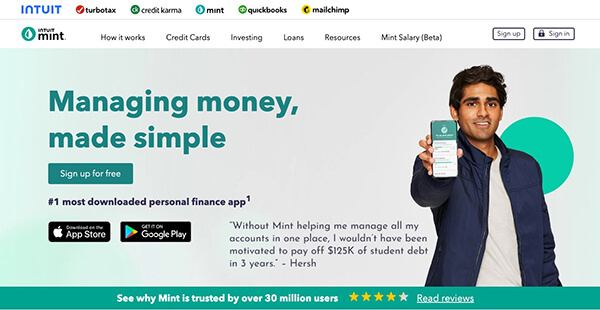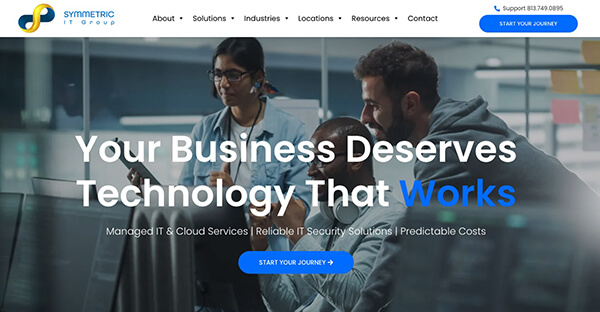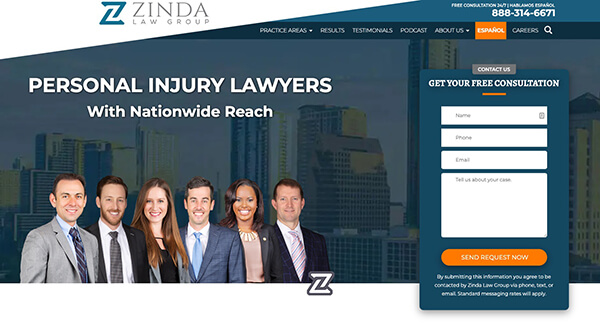As a service-based company, your website's homepage is often the first point of contact for potential clients. It's your first opportunity to make a great impression and to communicate what you do, who you serve, and why you're the best choice. However, creating a homepage that speaks to your ideal audience and optimizes for conversions can be a challenging task. In this blog post, we'll explore the benefits of optimizing your homepage with conversion-optimized strategies and a clear brand message, and provide some tips on how to get started.
Benefits of Optimizing Your Homepage for Conversions
A conversion-optimized homepage is designed to maximize the number of visitors who take the desired action on your site, such as filling out a contact form or scheduling a consultation. By optimizing your homepage for conversion, you can:
Increased Leads and Inquiries
One of the most important benefits of optimizing your homepage for conversion is an increase in the number of leads and inquiries your business receives. By creating a homepage that speaks directly to your ideal audience and prompts them to take action, you can capture more leads and inquiries from visitors who are interested in your services.
Improved Brand Recognition and Differentiation
A clear and concise brand message that speaks directly to your ideal audience can help improve your brand recognition and differentiation. By communicating what makes your business unique and highlighting the benefits you offer, you can stand out from competitors and establish yourself as a leader in your industry.
Need support in developing your brand message? As a StoryBrand Certified Guide, we can help you craft a message that speaks directly to your ideal audience. Schedule your free discovery call today!
Better Return on Investment (ROI)
Optimizing your homepage for conversion can also help improve your return on investment (ROI) from your digital marketing efforts. By attracting more qualified leads and increasing your conversion rates, you can generate more revenue and profits from your website and digital marketing campaigns.
Increased Customer Engagement
A homepage that appeals to your ideal audience and prompts them to take action can lead to increased customer engagement. By providing a positive user experience, you can build trust and credibility with your ideal audience, leading to increased loyalty and repeat business.
Improved Search Engine Rankings
Optimizing your homepage for conversion can also lead to improved search engine rankings. Search engines like to prioritize websites that provide a positive user experience and are optimized for conversion. By improving your website's user experience and optimizing your calls to action, you can improve your website's search engine rankings and attract more organic traffic.
By crafting a clear brand message, using engaging visuals, and including clear and compelling calls to action, you can capture more leads and inquiries, improve your brand recognition, increase customer engagement, improve your search engine rankings, and generate a better return on investment.
Homepage Conversion Optimization Strategies
Different business goals and target audience needs will require specific conversion strategies, but here are a few common homepage optimization strategies that a service-based business owner can use to improve their brand messaging and attract high-quality leads:
Clearly Showcase Your Value Proposition
Your value proposition is what sets you apart from your competitors and communicates the benefits of your services. A clear and concise value proposition should be prominently displayed on your homepage and communicate what you do, who you serve, and what makes you unique.
The “uniqueness” value of your value proposition should convey how your solution helps to solve their problem. The challenge? Making sure your value proposition positions your potential customer as the “hero” and your solution as the supporting actor.
Learn how to make your customer the hero with a 7 day free trial to Business Made Simple. On-demand courses, Live Coaching events, and playbooks to help you optimize the six key areas of your business.
Craft a Clear and Compelling Headline
Your headline should be attention-grabbing and compelling and should communicate your value proposition in a clear and concise way.
There are several ways copywriting frameworks that will help you craft that ideal message, but here’s the most important question to ask yourself:
If your website was just your headline and a call to action - would anyone take action based on your headline?
A pretty thought-provoking question, isn’t it?
Also, consider a sub-headline to boost clarity and add value to your headline statement.
And it bears repeating – keep your headline clear, not clever. Clarity sells, clever is just, well, cute.
Use Engaging Visuals
High-quality visuals, such as images or videos are a powerful way to capture the attention of your audience and convey information quickly. Consider adding infographics that can help visitors better understand your content.
While it’s best to use branded imagery to provide a more authentic experience, stock imagery can be used. Avoid the overly “stock photos and generic images” as they may be seen as impersonal. Smiling faces and in-action images help visitors to put themselves into the story you are conveying in both your copy and imagery.
Above all, make sure that your visuals are relevant to your services and target audience, and that they reinforce your value proposition.
Include Clear Calls to Action
The topic of calls to action is a significant subject within itself (and look for that blog post in the future), but for the purpose of your homepage optimization strategy, you want to make sure your page includes some.
You can spend all the money you want driving traffic to your website, but if you don’t call them to action, they’ll just enjoy reading your content and then bounce to another service provider who’s ready to work with them.
Calls to action should be exactly that - clearly defined next step action your lead should take to do business with you.
Is the next step a discovery call? Convince them to Schedule A Call Today!
Is the next step to book an appointment? Convince them to Book A Time Today!
Ideally, you should place your calls to action throughout your homepage, but 3 essential areas your action-oriented buttons should be placed are in your top navigation, your hero banner, and right above your footer.
Optimize for Search Engines
Again, this is another topic that can be discussed for days but know that optimizing your homepage for search engines can help attract more organic traffic and improve your search engine rankings. Use relevant keywords in your content, meta descriptions, and title tags, and ensure that your site has a clear site structure and is easy to navigate.
Provide Social Proof
Social proof, such as customer testimonials or case studies, can help build trust and provide credibility to your ideal audience.
Another idea for social proof is displaying a trust bar that highlights your awards, partnerships, certifications, PR mentions, etc.
How about a stats or metrics section that showcases statistics and figures? This section can either highlight a problem (that you can help solve) or present the results your solution has helped resolve.
Displaying social proof on your homepage communicates your expertise and demonstrates the results you have achieved for your customers.
Use Heatmaps and User Behavior Analytics
Tools such as heatmaps and user behavior analytics help you understand how visitors are interacting with your homepage and identify areas for improvement. By analyzing user behavior, you can identify which elements of your homepage are most effective and which areas need some adjustments.
Use tools like heatmaps to identify areas of improvement and then run some A/B testing to help nail down the best-performing optimization tactic.
An optimized homepage that effectively communicates your brand message and attracts higher-quality leads requires more than just a beautiful design. By clearly defining your value proposition, creating a compelling headline, using engaging visuals, including clear calls to action, optimizing for search engines, providing social proof, and using heatmaps and user behavior analytics, you can create a homepage that truly starts connecting to your ideal audience.
Common website conversion mistakes
While there are so many different ways to optimize a website for conversions, there are also several common mistakes that can negatively impact the user experience and reduce the effectiveness of the website.
While not an all-inclusive list, check your site against some of the most common website conversion mistakes, especially regarding a service-based website:
Unclear or Confusing Messaging
One of the most common mistakes is having unclear or confusing messaging. Your messaging should be clear, and concise, and directly communicate the value that your business provides. Avoid using technical jargon or complicated language that can confuse or alienate potential customers.
Poor Navigation
Another common mistake is poor website navigation. Your website should be easy to navigate, with a clear structure that helps users find the information they are looking for. Avoid cluttered pages, confusing menus, or difficult-to-find pages that can frustrate visitors and cause them to leave your site.
Lack of Social Proof
Social proof, such as customer testimonials or case studies, is important for building trust and credibility with potential customers. Not including social proof on your website can make it harder for potential customers to trust you and decide to work with your business.
No Clear Call to Action
Having no clear call to action on your website is another common mistake. Your website should have a clear call to action that encourages visitors to take the next step, such as filling out a contact form or scheduling a consultation. Without a clear call to action, visitors may leave your site without taking any action.
Slow Page Load Times
Page load times can have a significant impact on user experience and conversions. Slow load times can cause visitors to leave your site before it fully loads, resulting in lost opportunities for conversions. Make sure your website is optimized for speed and performance to minimize load times.
Poor Mobile Optimization
With more and more users accessing websites on their mobile devices, having a website that is not optimized for mobile can be a major mistake. Your website should be responsive, easy to navigate, and optimized for mobile devices to provide a seamless user experience for all visitors.
Understanding the common website conversion mistakes that many service-based businesses make will help know what you may need to improve on your own website. By addressing these issues, you can create a website that is optimized for conversions and provides a positive user experience for all visitors.
Real-World Examples of Conversion-Optimized Homepages
Let's take a look at some real-world examples of service-based companies that have optimized their homepages for conversion:
Mint, is a personal, financial management company that helps consumers manage their finances. Right away, the “above the fold” information features a clear value proposition, engaging visuals, calls to action as well as showcasing social proof.

Symmetric IT Group is an IT consulting company that specializes in helping small to medium size businesses with managed IT services. Take a look at their hero banner headline – doesn’t that really speak to a specific pain point? (One thing to note - I’m not crazy about the “Start Your Journey” message on the CTA buttons - seems to me it’s more “clever” rather than “clear”. What do you think?)

Zinda Law Group, personal injury lawyers that serve clients nationwide. This homepage displays a great call to action front and center in the hero banner section - a form to capture leads right away.

These companies have optimized their home pages for conversion by using clear brand messages, engaging visuals, and clear calls to action. They understand the importance of creating a homepage that speaks to their ideal audience and prompts visitors to take action.
Key Takeaways
You’ve learned the many benefits of optimizing your website including increased leads, improved brand recognition, and increased customer engagement. You’ve also learned some conversion optimization strategies and common mistakes.
The biggest takeaway to remember? Always be optimizing! Your business objectives will change, your audience needs will change, and we all know that search engine algorithms will change.
Keep your website in peak performance by making reviewing, testing, and optimizing your website an ongoing practice.
Tags:
Website Optimization
February 27, 2023



